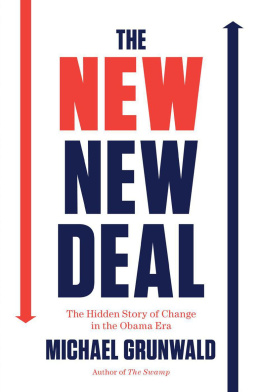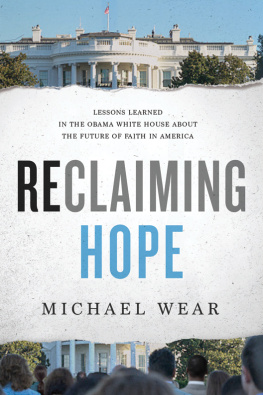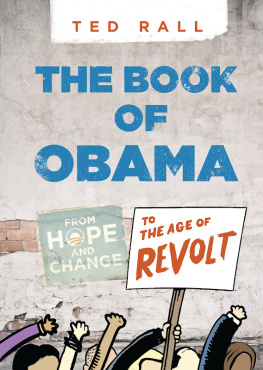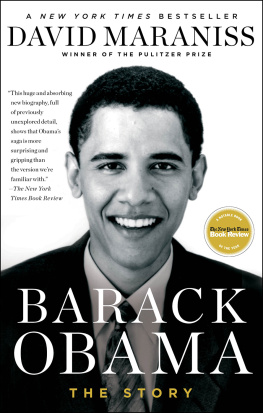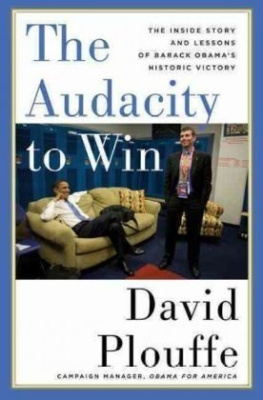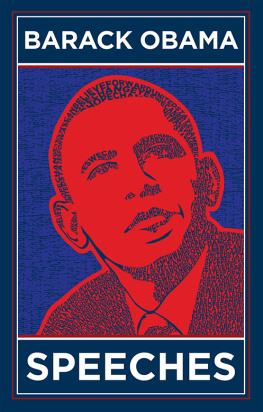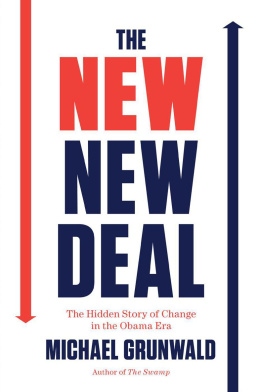
Thank you for purchasing this Simon & Schuster eBook.
Sign up for our newsletter and receive special offers, access to bonus content, and info on the latest new releases and other great eBooks from Simon & Schuster.
C LICK H ERE T O S IGN U P
or visit us online to sign up at
eBookNews.SimonandSchuster.com

CONTENTS
To Cristina ,
my stimulus
INTRODUCTION
Things That Never Were
C hange begins with a leap of faithnot a fairy-tale faith that tomorrow will always turn out better than today, or a rah-rah faith in the inevitable destiny of Gods most favored nation, but a more practical belief that the past is not necessarily prologue, that the future doesnt have to look like the present. Its progressive in the literal sense, not the polite-way-to-say-liberal sense, a simple faith in the possibility of progress. This basic notion that theres nothing preordained about the status quo can sound corny, and it doesnt make change happen. But it makes change possible.
This is what Barack Hussein Obama meant by the audacity of hope. And this was the wind behind his 2008 campaign, the promise of not just the change we always hear about but Change We Can Believe In, the idea that a skinny black guy with an inconvenient name and a thin rsum could ride a dream to the White House. It was easy to mock his Yes We Can hubris, his grandiose vows to transcend the pettiness of our politics and bridge the partisan divide, his messianic pledges to slow the rise of the oceans and usher in a new birth of freedom.drowned city, and finally the epic financial and economic collapsemillions of Americans were ready for a leap of faith.
What happened to that changeand that faithis the central story of the Obama administration.
The prevailing narrative has emphasized the unfulfilled promise, the change were still waiting for, the gap between the lofty poetry of Yes We Can and the transactional tawdriness of If We Can Round Up The Votes. The partisan divide remained un-bridged, the pettiness of our politics un-transcended. And the economy stubbornly refused to comply with Obamas rhetoric of revival, setting the tone for a narrative of disappointment: Wasnt the audacity of hope supposed to make people feel better? Hadnt he promised to reinvent the economy to seize the future? What happened to the strong middle class and the new American century and all those other nice things that were supposed to materialize after his historic election? Hope and change became a partisan punch line, the wink behind Sarah Palins sly taunt: Hows that hopey-changey stuff working out for ya?
In the 2010 congressional elections, Americans gave a preliminary answer, voting to change the change, smacking down Democrats, rewarding Republicans for resisting the Obama agenda. Even the president toned down the hopey-changey stuff as his approval ratings slumped, reminding supporters that he was elected to make things better over time, not to make things perfect overnight.
Weve always known that lasting change wouldnt come quickly or easily, he wrote in the strangely muted email announcing his reelection campaign. It never does.
Thats part of the story: Change is hard.
But theres more to the story: Change is happening.
It isnt happening because a politician waved a magic wand. Its happening the way change happens in American democracy, through legislation that Congress passes and a president signs and bureaucrats implement.
This is the story of Obamas most ambitious and least understood piece of legislation, the purest distillation of what he meant by change. It aimed to repair a broken economy while reforming our approach to energy, health care, education, taxation, transportation, and more. Its starting to change our cars and our trains, the way we produce and consume electricity, the way our schools teach, our doctors practice, and our government spends our money.
Its even trying to change photosynthesis, which is as good a place as any to begin the story.
S ure, photosynthesis has been working reasonably well for 3.5 billion years, making plants grow, releasing the oxygen that sustains life on earth. But at the dawn of the Obama administration, it wasnt working well enough for the presidents hard-charging energy secretary, Steven Chu, a quantum physicist who had won a Nobel Prize for trapping and cooling atoms with lasers. Chu had the toothy grin, dorky glasses, and wispy build of a tech nerd, but he had a steely side, too. He didnt accept that problems were unsolvable unless there was scientific proof.
Chu was at the vanguard of a new brigade of egghead elitesa new, ultra-confident Best and Brightestwho marched into Obamas Washington because they believed all that hopey-changey stuff. At sixty, he was a renewable energy source in his own right, exuding the boyish enthusiasm of a junior high geek dissecting his first frog. He worked eighty hours a week trying to rev up the sluggish Department of Energy, then spent his spare time doing the kinds of things geniuses do, like trying to cure cancer with nanotechnology, and using an atom interferometer to confirm a key prediction of Albert Einsteins theory of relativity.the gospel of clean energy, sharing the good news of solar power, geothermal heat pumps, and energy-saving white roofs.
He wanted biofuels in his scripture, too. Fuels derived from biomass had been hyped as the great green hope, the renewable key to a world without oil. As a farm state senator, Obama had always portrayed ethanol and other biofuels as miracle elixirs. But Chu suspected they would never outcompete fossil fuels as long as they relied on photosynthesis. It was a chemistry thing. Harvesting sunlight to grow corn or switchgrass or even algae was just an awfully circuitous strategy for producing fuel, like a journey from New York to Washington via San Francisco. More than 99 percent of the solar energy was wasted along the route. Photosynthesis, Chu liked to complain, is too damn inefficient.
Fortunately, a new agency called ARPA-E had just been created inside Chus department to solve problems like photosynthesis.
The Advanced Research Projects Agency-Energy was a government incubator for high-risk, high-reward, save-the-world private energy research, the kind of place where Q from the James Bond movies would want to work. Modeled after DARPA, the legendary Pentagon agency that fathered the Internet and GPS technology, it was designed to finance out-of-the-box, early-stage experiments that probably wouldnt pan out, but just might point the way toward truly clean coal or a truly smart grid or a truly green economy if they did. Chu was ARPA-Es intellectual godfather; he had proposed the agency while serving on a National Academy of Sciences panel on U.S. competitiveness. He had handpicked its first director, his former Berkeley colleague Arunava Majumdar. And he had set its reach-for-the-stars tone, making it clear that ARPA-E wasnt about incremental improvements. The agencys mantra was: Game-changers only.
ARPA-E felt more like a high-tech start-up than a federal bureaucracy, with a foyer cluttered with intimidating textbooks on tribology, constructal theory, and nanostructure physics, and walls dotted with dreamy Yes We Can messages from Martin Luther King Jr. (We are confronted with the fierce urgency of now), John F. Kennedy (We need men who can dream of things that never were), and Chu himself (Resist the urge to accept the status quo). It was exempt from the usual civil service rules, and it attracted an absurdly high-powered staff of brainiacs: a thermodynamics expert from Intel who had published sixty-five scientific papers, an MIT electrical engineering professor who had founded two start-ups, a clean-tech venture capitalist who also taught material science at MIT. Majumdar, a world-renowned energy expert, had run Berkeleys nanotechnology institute before Chu persuaded him to leave his tenured chairas well as his wife, two children, and a yellow Labbehind in California to make change in Washington. His deputy, Duke biochemistry professor Eric Toone, was also a biotech entrepreneur who had helped develop a promising glaucoma drug.
Next page
